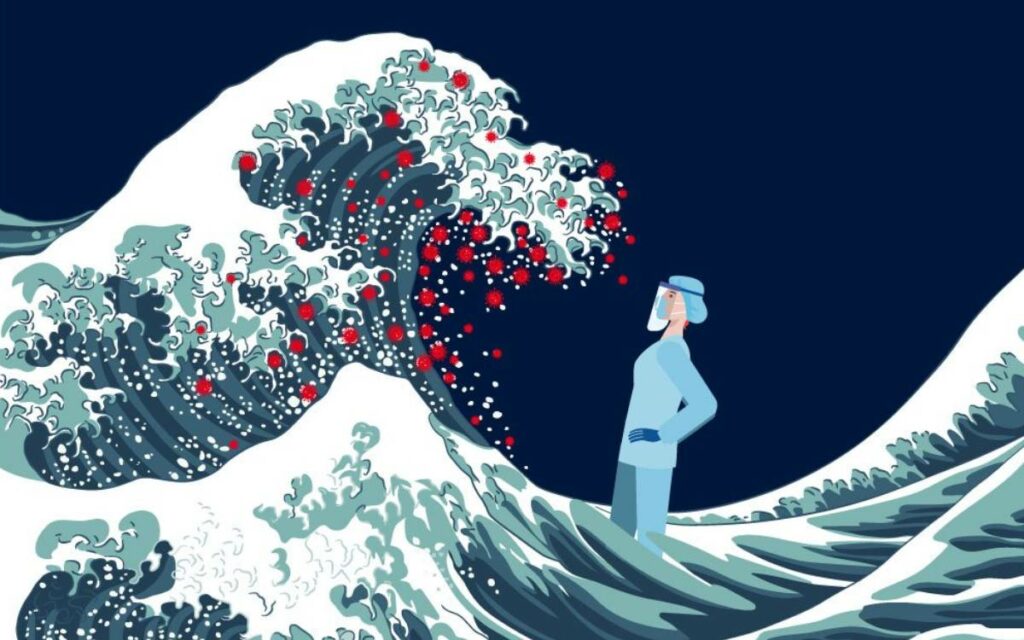
As Niagara teeters on the brink of a second lockdown, we’re starting to see some signs of just what this second wave will look like. Put bluntly, it doesn’t look good.
We always knew that the battle with COVID-19 would be a back and forth affair. One of the earliest major public policy documents addressing the crisis was called “The Hammer and the Dance”, in which Tomas Pueyo described how – even after we lower the “hammer” of quarantine and isolation – we would enter an extended period of “dance” in which the infection rate rises and falls, and our shutdowns and public health measures follow suit.
What we may not have counted on was the fact that our current crop of anti-vaxxers would also fail to understand the complexities of pandemic science. Aided and abetted by the politicization of COVID-19 south of the border, this has contributed to an alarming spike in cases across Canada and around the world. Ultimately, this means that Pueyo’s hammer must descend once again, as we seek to contain the outbreak, save lives, and protect the viability of the health care system.
That doesn’t mean that the latest round of coronavirus responses isn’t without some absurdities, of course. Imagine two people who carpool to work, and sit in the same office all day… our coronavirus rules currently prohibit them from having lunch together, or sitting together for a beer on the way home from work. But that’s the nature of hammers – when they fall, it doesn’t matter whether you’re a nail or a thumb, there’s going to be some impact.
Like it or not, that impact is going to be felt most in the small business community, and it won’t be distributed evenly. Some businesses are going to be far more impacted than others, including:
- Businesses impacted by social distancing guidelines – If people are required to stay at least two metres apart, this will certainly create issues for restaurants, bars and gyms, but also for daycares, spas, hair salons and a range of medical businesses from dentists to chiropractors.
- Businesses impacted by travel restrictions – We already know the tourism industry is struggling, but we can also see (for example) that less driving means fewer car sales, fewer auto repairs, lower gasoline sales, and smaller insurance premiums, all of which directly impact the bottom lines of many local businesses.
- Businesses impacted by lower levels of consumer confidence – We’re all scared, and many of us are actually earning less than in the past, which has caused one of the biggest transformations of consumer spending patterns in modern history, and has turned traditional retailing on its head.
All of this means that as COVID rates ratchet back up, we will see more businesses in real trouble (and we should note that Niagara’s businesses are concentrated in areas like tourism and retail that will be particularly impacted). So how is that different from when this happened in the spring?
Back in the spring, federal and provincial governments rolled out emergency loans and introduced wage subsidy programs. They subsidized the purchase of protective equipment and delivered rent support. They paid for retailers to go online and gave emergency support to workers without pay. And – to their credit – it worked. We survived the first wave of the pandemic, and although some businesses were lost, many others were saved.
Now we’re in for round two. Some of those past support programs continue, like the wage subsidy program. But many others were “one and done”. If you got an emergency loan in March, for example, you can’t get one now. But Wave Two has arrived, and it may be much worse than the first time around.
To be fair, there are new programs rolling out. The Ontario Chamber of Commerce can provide up to $5,000 for a new website. The Export Development Corporation (EDC) has a new program to help with international marketing. By and large, though, there’s precious little in the way of new programming to support most small businesses. And what is available will not be enough to help some businesses survive the next wave of the pandemic.
Perhaps that’s OK. It’s not the job of government to run (or maintain) business and one of the key considerations for any small business owner or any entrepreneur is risk. When we launch a business, we make a bet, and the bet doesn’t always pay off. The problem this time is that it won’t be just the business owners and entrepreneurs who have to settle up on that bet. Our workforce is built around the jobs provided by small business. Our municipal budgets and programs rely heavily on business taxpayers.
As our small business sector takes a huge hit over the next six months, we need to be working on two key efforts. First, we should all be making conscious decisions about our own behaviour, and explicitly working to support small business. That means making deliberate choices to patronize and support those small businesses where and how we can. But it also means doing every single thing in our power – including self-isolating and strictly following public health guidelines – to crush the pandemic. Second, it means that we have to recognize that many small businesses will collapse in 2021. As a community, we must be aggressively focused on cultivating and supporting a new generation of entrepreneurs and small business startups in the new year.
It may be that vaccines and treatments will end the pandemic within the next six or eight months, which is good news. However, the crushing impact of Wave Two means that for many of us, the real work of recovering from the coronavirus has yet to begin.

Brock Dickinson is a serial entrepreneur and innovator who has worked with hundreds of companies and communities in more than 30 countries. He holds a number of innovation support roles, including his work as and Adjunct Professor and Entrepreneur in Residence at the University of Waterloo, and as an Executive in Residence with Innovate Niagara. He lives in the Niagara Region.








